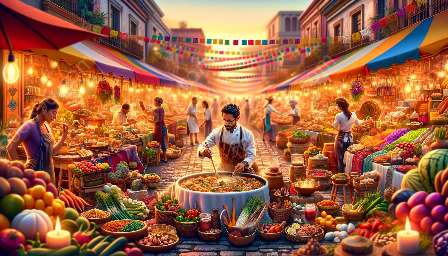Latin American cuisine is a beautiful fusion of indigenous, European, African, and Asian culinary traditions, shaped by centuries of colonial history and cultural exchange.
The history of Latin American cuisine is a vivid tapestry of flavors and techniques, showcasing the influence of colonial powers and the rich tapestry of indigenous ingredients and cooking methods. The fusion of these diverse culinary legacies has given rise to a vibrant and diverse food culture that reflects the complex history and heritage of Latin America.
Colonial Influences
The colonial period in Latin America saw the convergence of diverse culinary traditions from around the world. The Spanish, Portuguese, French, and British colonial powers brought their own culinary influences to the region, introducing new ingredients, spices, and cooking techniques to the indigenous population.
These European colonizers introduced staples such as wheat, rice, sugar, and livestock, which significantly transformed the local cuisine. In addition to foodstuffs, they also brought their own culinary traditions and cooking methods, which blended with the indigenous cooking styles to create unique and flavorful dishes.
Indigenous Heritage
Prior to the arrival of the European colonizers, Latin America was already home to a rich and diverse culinary tradition. Indigenous peoples such as the Aztec, Maya, and Inca had developed sophisticated agricultural practices and culinary techniques, cultivating a wide variety of crops like maize, potatoes, quinoa, and beans.
These indigenous ingredients form the backbone of Latin American cuisine, providing the foundation for many traditional dishes and culinary practices that continue to be celebrated today. The fusion of these indigenous ingredients with European flavors and cooking techniques gave birth to an entirely new and exciting culinary landscape.
African Influence
The African influence on Latin American cuisine is another integral part of the culinary tapestry of the region. The transatlantic slave trade brought African slaves to the colonies, along with their own culinary traditions and ingredients. The fusion of African flavors and cooking techniques with indigenous and European elements gave rise to a vibrant Afro-Latin culinary heritage.
African ingredients such as okra, yams, and plantains, as well as cooking techniques like braising and stewing, became integral parts of Latin American cuisine, adding depth and complexity to traditional dishes. The influence of African culinary traditions is particularly pronounced in countries with a significant Afro-Latin population, such as Brazil, Cuba, and Colombia.
Culinary Diversity
One of the most striking characteristics of Latin American cuisine is its incredible diversity. Each region and country within Latin America has its own unique culinary traditions, shaped by a combination of indigenous, European, and African influences. From the ceviche of Peru to the empanadas of Argentina, and the mole of Mexico, Latin American cuisine reflects a rich tapestry of flavors and techniques.
Moreover, the fusion of colonial and indigenous cuisines has given rise to a wide variety of fusion dishes that blend the best of both culinary worlds. Dishes such as tamales, feijoada, and arroz con pollo showcase the harmonious integration of ingredients and cooking techniques from multiple culinary heritages, creating a truly cross-cultural dining experience.
Modern Innovations
While traditional dishes and culinary techniques continue to form the backbone of Latin American cuisine, there is also a growing trend towards culinary innovation and fusion. Many chefs and cooks in Latin America are exploring new ways to blend traditional ingredients and flavors with modern cooking techniques, resulting in a renaissance of Latin American cuisine.
From upscale restaurants to street food vendors, the contemporary culinary landscape of Latin America is a vibrant playground of creative expression, where traditional dishes are reinterpreted and reinvented in exciting and innovative ways. This blending of old and new, tradition and innovation, ensures that Latin American cuisine remains a dynamic and ever-evolving culinary tradition.
Conclusion
The colonial fusion of cuisines in the Latin American context has given rise to a vibrant and diverse food culture that reflects the complex history and heritage of the region. Influenced by indigenous, European, African, and Asian culinary traditions, Latin American cuisine is a beautiful tapestry of flavors and techniques that continues to evolve and innovate, while remaining deeply rooted in tradition.
As you explore the rich history and cultural fusion of Latin American cuisine, you'll discover the unique blend of flavors and techniques that characterize the diverse culinary heritage of Latin America, making it a truly unparalleled culinary experience.

